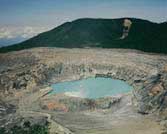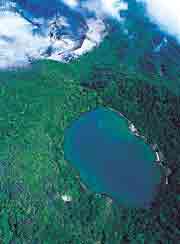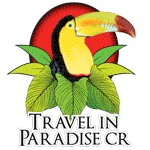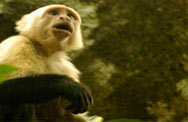|
|
Poas Volcano National Park**(5)
Like the other volcanoes in the Central Volcanic Cordillera, the silhouette of Poás Volcano as seen from the Central Valley gives no hint of the power and pent-up fury below the surface. But once at the summit and standing on the crater's rim, it becomes easier to understand the forces that have shaped this region of the planet.

With a diameter of 1.5 km., the active crater is reportedly the widest of any volcano in the world. If it is clear enough to see to the bottom of the 300-meter deep crater, you will surely observe some type of activity ranging from fumaroles to bubbling emissions on the surface of the small rain-filled lake to actual geyser-type eruptions, but it is constantly changing. During the early 1990s, there was enough geyser activity to cause the lake to lose its water by the end of the dry season (April/May); this resulted in increased gaseous emanations that forced the park to close on a few occasions.Looking to the left of the crater you can see the deleterious effects of the volcanic gases that cause a localized form of acid rain. For several kilometers downwind from the crater the vegetation is brown and dying. A few meters back down the trail from the active crater overlook, a 1.5 km. trail leads off to Lake Botos, a densely forested dormant crater filled with rain water. A portion of this trail goes through an eerie-looking section of stunted forest. The trunks and branches of the small trees here are gnarled and twisted from the harsh climatic conditions in exposed areas at high elevations. At the Lake Botos overlook you'll be near the highest point in the park which is 2,704 meters. At this elevation wildlife is not particularly abundant, but there is usually a fair amount of bird activity. Some of the more common species are the Fiery-throated Hummingbird, Sooty-capped Bush-Tanager, Slaty Flowerpiercer, Mountain Eleania, Black-billed Nightingale-Thrush, and Black-and-yellow Silky-Flycatcher. Given its high visitation, the National Park Service has chosen Poás as a model park. One of the benefits of this is the Visitors' Center which presents a thorough explanation of vulcanism and the natural history of Poás using a variety of entertaining and informative displays. At this elevation wildlife is not particularly abundant, but there is usually a fair amount of bird activity. Some of the more common species are the Fiery-throated Hummingbird, Sooty-capped Bush-Tanager, Slaty Flowerpiercer, Mountain Eleania, Black-billed Nightingale-Thrush, and Black-and-yellow Silky-Flycatcher. Given its high visitation, the National Park Service has chosen Poás as a model park. One of the benefits of this is the Visitors' Center which presents a thorough explanation of vulcanism and the natural history of Poás using a variety of entertaining and informative displays.
Climate: It can get cool at this 2,500+ meter elevation, so layers are advised. If it is sunny, use plenty of sunscreen because the thinner air lets the UV rays through even more intensely than if you were at the beach. Mornings tend to be clear, but the clouds can build up quickly. The driest months are from January to April.
|
Travel Tips:
FAQs: You might be wondering too.
About CR
About weather
What to pack: click here to get ideas on what you really need to bring along.
What to wear: click here to get ideas on what to wear. Avoid mistaken clothes.
Our Specialty Your Best Travel, vacations Family Trips, Honeymoons, Educational Trip, Escorted Trip.
Honeymoon Beyond a romantic setting, a honeymoon in Paradise is a magical experience.
Family oriented Trip
: Is about experiencing fascinating cultures, family adventures, family tours, quality time together.
Incentives travels: Creative ideas, consulting services for a theme party or special event.
|




 At this elevation wildlife is not particularly abundant, but there is usually a fair amount of bird activity. Some of the more common species are the Fiery-throated Hummingbird, Sooty-capped Bush-Tanager, Slaty Flowerpiercer, Mountain Eleania, Black-billed Nightingale-Thrush, and Black-and-yellow Silky-Flycatcher. Given its high visitation, the National Park Service has chosen Poás as a model park. One of the benefits of this is the Visitors' Center which presents a thorough explanation of vulcanism and the natural history of Poás using a variety of entertaining and informative displays.
At this elevation wildlife is not particularly abundant, but there is usually a fair amount of bird activity. Some of the more common species are the Fiery-throated Hummingbird, Sooty-capped Bush-Tanager, Slaty Flowerpiercer, Mountain Eleania, Black-billed Nightingale-Thrush, and Black-and-yellow Silky-Flycatcher. Given its high visitation, the National Park Service has chosen Poás as a model park. One of the benefits of this is the Visitors' Center which presents a thorough explanation of vulcanism and the natural history of Poás using a variety of entertaining and informative displays.







